Is the UK still in drought? Areas where hosepipe bans remain and when will it ease
and live on Freeview channel 276
As the UK sees the end of a wet July, the Environment Agency (EA) is preparing for all weather eventualities - including drought.
In June, the EA announced that the Devon, Cornwall and Isles of Scilly Areas are still in a water supply drought due to the levels in South West Water’s strategic reservoirs. Roadford and Colliford reservoir storage is improving but remains low for this time of year. A Temporary Use Ban (hosepipe ban) was in force in Cornwall and most of Devon (in the Roadford supply zone).
Advertisement
Hide AdAdvertisement
Hide AdAt this week’s meeting of the National Drought Group (Wednesday 19 July) - chaired by Environment Agency Executive Director John Leyland - senior decision-makers from the Environment Agency, government, water companies and key farming and environmental groups discussed the best ways to manage water resources and ensure preparedness if hot, dry weather returns to this country.


This meeting follows the hottest June on record. Although July has been very wet in many places, rivers that were struggling with low flows have responded with most now back into normal ranges.
The group also discussed how the country can no longer rely on past weather patterns and that the best time to conserve water is when it is raining.
But despite the recent wet weather, the EA continues to prepare for all weather eventualities for the rest of summer and autumn - which includes closely monitoring the environment and ensuring we understand the risks if dry weather returned.
Advertisement
Hide AdAdvertisement
Hide AdRecent rainfall over the last three weeks, particularly in north west England, has meant Cumbria and Lancashire has now returned to normal status. The wet weather has restored river flows in many parts of the country and reduced temperatures in the water environment, which has helped fish and other wildlife. However, the National Drought Group warned that the situation could regress if hot, dry weather returns later in the summer.
Environment Agency Executive Director and NDG Chair John Leyland said: "Our climate is changing - this year we’ve seen more record-breaking temperatures in the UK, historically wet months followed by historically dry months, and an extreme heatwave sweeping through southern Europe.
"Yesterday is no longer a reliable predictor of tomorrow – together we must adapt to ensure we, and our water supplies, are resilient into the future. Preparation starts when it is raining; we must all use the wet weather to conserve water.
"The Environment Agency will continue to work collaboratively across the water sector to manage drought risk, including ensuring water companies implement their drought plans, managing abstraction licenses and helping farmers to manage resources."
Advertisement
Hide AdAdvertisement
Hide AdAs of July 2023, Devon, Cornwall and parts of East Anglia remain in drought. The Environment Agency anticipates that these areas in drought will not return to normal status until at least winter. As of 19 July, total reservoir capacity across England is 79% full and the July rainfall total so far for England was 65mm.
Hosepipe bans are still in place for Devon and Cornwall to help manage demand with water supply reservoirs still recovering from last year’s drought. Hosepipe bans also remain in place in Kent and Sussex - but this is due to increased demand for water in hot weather, which is impacting how quickly treated water storage reservoirs can be refilled, not because of drought conditions.
Comment Guidelines
National World encourages reader discussion on our stories. User feedback, insights and back-and-forth exchanges add a rich layer of context to reporting. Please review our Community Guidelines before commenting.
